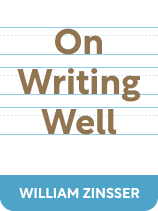

This article is an excerpt from the Shortform book guide to "On Writing Well" by William Zinsser. Shortform has the world's best summaries and analyses of books you should be reading.
Like this article? Sign up for a free trial here .
Do you want to achieve clarity in your writing? What is the key to writing clearly?
Whether you’re writing fiction or nonfiction, politics or humor, sportswriting or essays, clarity in writing is extremely important. If your writing isn’t clear, you won’t be able to properly convey your point.
Here’s how to write more clearly.
What Is Clarity in Writing?
Once you’ve achieved simplicity in wording and structuring your sentences, focus on bringing clarity to your writing. In his book On Writing Well, William Zinsser believes that it’s your job as a writer to guide the reader through your thought process rather than forcing them to dissect disorganized or underdeveloped writing.
For example, consider how the second sentence loses clarity: “Megan and Courtney walked to the end of the street before parting ways. Then she walked into a nearby coffee shop.” Who is “she” referring to—Megan or Courtney? Something as simple as a vague pronoun can disrupt the clarity of your writing.
Zinsser believes to achieve clarity in writing, you must clearly understand the topic you’re writing about. If you don’t understand the topic, you’ll never be able to explain it well to your reader.
Follow a Logical Sequence
To write with clarity, follow a logical sequence of ideas. Each sentence should build off of the idea in the previous sentence. To lead your reader to your next thought, Zinsser recommends anticipating what the reader will ask and answering their question in the next sentence, rather than repeating the previous sentence in a different way.
If you’re having trouble writing with clarity, Zinsser recommends writing about a scientific or technical subject, such as how Bluetooth works or the migration pattern of monarch butterflies. The purpose of this exercise is to clearly explain how something works. First, you’ll need to fully understand the subject, otherwise there will be holes in your logic. Then, explain the steps you used to understand the topic. With scientific subjects, you’re less likely to omit key steps since you won’t assume your reader already knows certain facts. If you assume a reader already knows something and omit defining, explaining, or connecting your ideas, you lose clarity and confuse your reader. By completing this exercise, you’ll learn to clearly explain a logical process.
Signposts
Zinsser believes that you can increase the clarity of your writing with signposts. Signposts are words that connect ideas and indicate the progression of your thoughts, such as “first” or “finally.” Signposts tell your reader what direction you’re going next, guiding your reader through your logic.
For example, imagine you write, “I made the cake. I poured in the milk, melted butter, and eggs. I mixed it all together. I put the batter in a pan. I baked it at 350 degrees.” While these sentences are all simple, they lack clarity because they don’t connect to each other. To bring clarity to these ideas, include signposts: “I made the cake. To do this, I poured in the milk, melted butter, and eggs. Next, I mixed it all together. Then I put the batter in a pan before baking it at 350 degrees.” The italicized signposts indicate the sequence of events, providing clarity.
While signposts signal the progression of logic, they can also signal changes in tone. For example, your boss sends you an email, and the first paragraph congratulates you on your most recent project. But the second paragraph begins with, “however.” This signals that your boss’s tone and topic change in this paragraph. From “however,” you know that the tone of the second paragraph will no longer be congratulatory, and the topic will change from commenting on your presentation to something else.
| Choose the Right Type of Signposts Zinsser mentions a few examples of common signposts but doesn’t discuss the different categories of signposts, which can direct and organize our next thoughts. Knowing where your sentences are heading, and what category your next thought falls into, can help you choose the right signpost. There are several types of signposts: -To add more ideas: again, furthermore, in addition, moreover -To compare or contrast ideas: alternatively, contrastingly, conversely, whereas -To prove something: evidently, for this reason, because, inevitably -To show exceptions: however, nevertheless, yet, in spite of -To repeat or refer back to something: as mentioned earlier, or as previously discussed -To show that you will include something later: this will be discussed in detail later -To emphasize something: definitely, obviously, inevitably, undeniably -To give an example: for instance, in this case, in particular, notably -To show chronology: previously, following this, initially, subsequently, finally However, experts warn that you shouldn’t over-signpost. Too many signposts can make your writing wordy and give the impression that you don’t trust the reader’s ability to make connections. Also, don’t substitute logically building off of your previous sentence with a signpost. You should still thoroughly explain your ideas. |
Be Consistent
Being consistent will help you write with clarity. Consistency, or what Zinsser calls unity, is when certain key elements of your writing stay the same throughout your writing, even as your idea develops. For example, tone is one key element to keep consistent in a piece of writing, as we’ll discuss. Zinsser believes consistency eliminates unwanted confusion because your reader won’t have to keep up with unnecessary changes in your writing.
Zinsser explains that while you can take some artistic liberty with your writing, you have to stick with whatever decisions you make. As you write, you can change your mind, but make sure that change is reflected throughout the rest of your writing. For example, you may start writing a piece in third person, only to decide midway through that you think first person would work better. It’s okay to change your mind, but be sure to go back and change the parts you’ve already written in third person to first person.
| Be Consistent With Punctuation and Spelling Zinsser points out the importance of consistency with big decisions like tone, main idea, tense, and point of view. But it’s also important to be consistent for small decisions like punctuation and spelling. Experts cite several reasons to be consistent about these small decisions: – Consistency makes writing easier on you. For example, if you make a conscious decision to use the Oxford comma, you won’t have to keep deciding whether or not to use one later in your piece. – Consistency makes you seem like a more credible writer. When a reader notices inconsistencies, such as using “judgment” and “judgement” in the same piece, she might consider the writing amateur. – Consistency makes your writing look polished and professional—it’s a subtle way to show your reader that you’ve paid attention to the details. To ensure consistency in writing, some publications and businesses adhere to a style guide. Some of the more common style guides are AP style, Chicago style, APA style, and MLA style. You can use these guides as a reference to answer certain consistency questions about spelling, word hyphenation, punctuation, and more. |
Zinsser discusses four decisions you should make to ensure you’re consistent. These decisions are your promise to the reader that you won’t try to confuse or trick them. To ensure you stay consistent in your artistic decisions, ask yourself these four guiding questions:
What’s Your Main Idea?
Zinsser believes that to bring clarity to your writing, the most important question you should ask yourself is, “What’s the main idea?” Your main idea is the most important takeaway from a piece—it’s your whole reason for writing that specific story.
Zinsser explains that your main idea will guide your writing and prevent unrelated tangents. When you have a clear main idea, all of the creative decisions you make will focus on clearly communicating it. This doesn’t mean you can’t explore other ideas in your piece, but those ideas should support your main point.
Zinsser contends that you’ll be better off writing in-depth about a specific idea than writing vaguely about a broader topic. You’ll have more space to explore details and discuss the topic thoroughly. So when deciding your main idea, be more specific than you think you need to be.
For example, imagine a writer who wants to write about life in New York City. Following Zinsser’s advice, he narrows his focus to writing about life in the Bronx in New York City. He narrows it further to one neighborhood in the Bronx. Finally, he narrows it to one family in the neighborhood. By taking a specific focus, he’ll be able to write a more realistic description of their lives. In doing so, he’ll reveal more about life in New York City than if he tried to write more broadly about the many different experiences of people living there.
| Identify Your Main Idea If you’re still struggling to narrow down your main idea, ask yourself a few questions: – What made you start writing the story in the first place? What was your motivation to write? – What is the main conflict in your story? – Can you summarize your story in one sentence? What keywords stand out to you? Ask yourself these questions before you start writing. Some experts believe many writers make the mistake of writing prematurely. They advise against using writing to work out your thoughts, which can make your writing unorganized and repetitive. Instead, ask yourself what you want your reader to gain from your writing, and don’t start writing until you have a clear answer. |
What Point of View Will You Use?
The next clarifying question you should ask yourself is, “What point of view will I use?” Your point of view is how you narrate your piece. Your point of view establishes a relationship with the reader since it’s how you’ll refer to yourself throughout the story.
There are three points of view: first, second, and third person.
- First person uses self-referential pronouns, such as “I” and “we.” In first person, the writer is an active participant in the story since her observations are included.
- Second person uses pronouns like “you.” In second person, the writer is more removed from the story than in first person.
- Third person uses pronouns like “he,” “she,” and “they.” In third person, the writer is the most removed from the story, acting as an observer rather than a participant.
Whatever point of view you decide on, make sure it’s consistent throughout your piece so your reader doesn’t question your reliability as a narrator. If you switch points of view in your writing, you’ll confuse your reader. For example, if your friend Beth emails you about her trip to the beach and says, “I had such a great time! The water was freezing, but Beth still went swimming,” it would be confusing as she switches from first person (“I had such a great time!”) to third person (“Beth went swimming”).
What Tense Will You Use?
Next, create clarity by deciding what tense you’ll write in and using that tense consistently throughout your piece. Zinsser notes that tenses help your reader situate themselves in the timeline of events.
Zinsser discusses the two most common tenses: past and present.
- Past tense discusses events that happened in the past. Write in past tense when you’re looking back on an event. For example, “I walked to the store,” or “Lauren turned to Joe and asked him a question.”
- Present tense discusses events in the current moment. Use present tense when you’re writing about things as they’re happening. For example, “I’m walking to the store,” or “Lauren turns to Joe and asks him a question.”
(Shortform note: Although Zinsser doesn’t discuss it, there is also the future tense, which discusses events that haven’t—but are expected—to happen. In English, our version of future tense uses “will” and a verb, such as in, “I will go to the store.”)
Zinsser explains that you should choose one main tense to tell your story, and use different tenses as appropriate. For example, if you’re telling a story using present tense and someone tells the narrator (in the present) about a story that happened to them (in the past), writing in a different tense for this dialogue is warranted.
But, if you switch your primary tense, you’ll confuse your reader because they won’t be sure of the chronology of events. Using the example from the previous section, let’s say Beth wrote, “I had such a great time! The water is freezing, but I’m still swimming.” At first she speaks in past tense, and then she switches to present tense. Switching the second sentence to present tense throws off the logic of Beth’s story.
What Tone Will You Have?
Finally, your tone will affect the clarity of your writing. Zinsser explains that tone signals what you think or how you feel about your topic. For example, you could take a lighthearted, nostalgic, or formal tone toward your writing.
(Shortform note: While tone signals your attitude toward a topic, your tone can also contribute to how the reader feels from reading your piece. So tone is important not only for reader understanding but also for reader response.)
Zinsser advises keeping your tone consistent throughout a piece of writing to eliminate confusion. If the reader doesn’t know how you feel about a subject, she’ll be confused by your writing. Thus avoid switching between tones in your piece. For example, if a journalist wrote about a devastating tsunami and switched from a serious, concerned tone to a light, humorous one within that piece, he’d get backlash from confused readers.

———End of Preview———
Like what you just read? Read the rest of the world's best book summary and analysis of William Zinsser's "On Writing Well" at Shortform .
Here's what you'll find in our full On Writing Well summary :
- A back-to-basics approach to the craft of writing
- How to practice simple, clear, and engaging writing—even if you're not a writer
- How to effectively put your ideas into words





